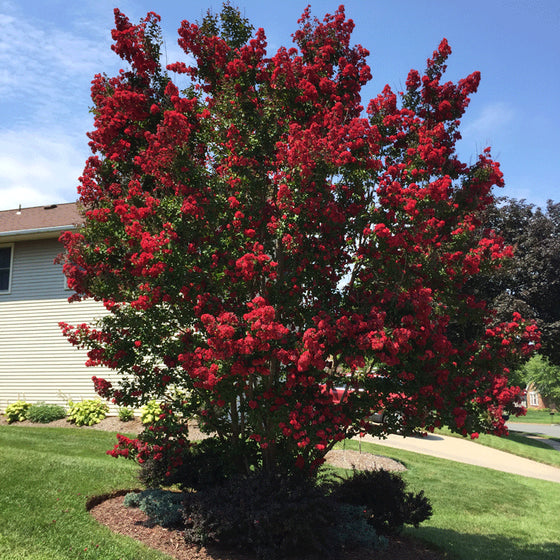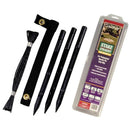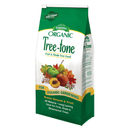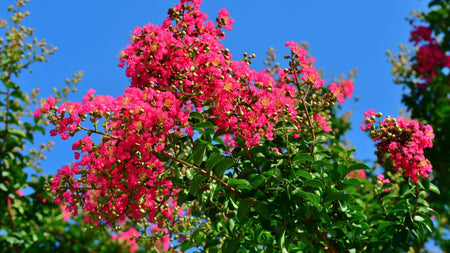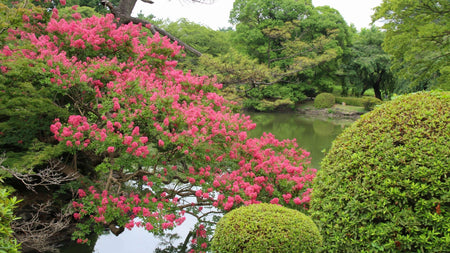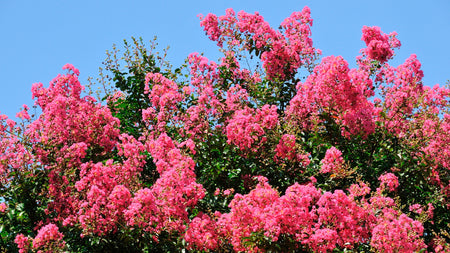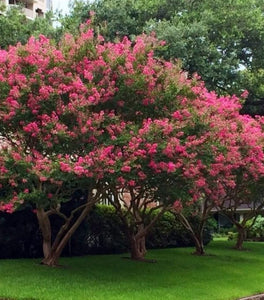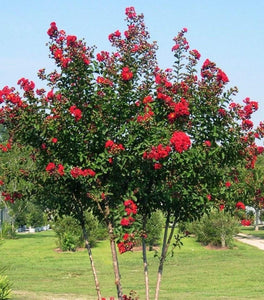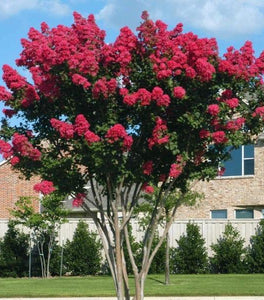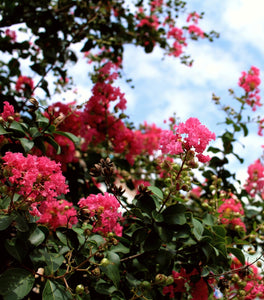
Images Depict Mature Plants
Double Dynamite Crape Myrtle Trees
Double Dynamite Crape Myrtle (Lagerstroemia indica ‘Whit II’ PP#23,914) is an extraordinary ornamental shrub or small tree prized for its dazzling, deep red flowers and exceptional reblooming power. Blooming continuously from mid-summer through early fall, Double Dynamite lives up to its name by producing vibrant, eye-catching color that electrifies any sunny landscape. This vigorous grower features rich green foliage that emerges with a reddish tint in spring and often turns burgundy in fall, providing outstanding multi-season interest. Growing to a manageable size of 8 to 10 feet tall and wide, it’s ideal for foundation plantings, colorful privacy screens, or as a striking specimen tree.
Thriving in full sun and well-drained soil, Double Dynamite Crape Myrtle is highly resistant to powdery mildew and other common crape myrtle diseases, ensuring that its foliage stays clean and healthy throughout the season. Once established, it boasts impressive drought tolerance, making it a low-maintenance option for gardeners seeking vibrant, long-lasting color with minimal effort. Its dense, upright growth habit and profusion of bold red flowers make Double Dynamite a popular choice for adding structure, height, and dramatic color to garden beds, mixed borders, or large containers.
Whether you’re designing a new landscape or refreshing an existing one, Double Dynamite Crape Myrtle offers unbeatable performance with its intense flower power, multi-season foliage color, and easy-care nature. Its ability to rebloom consistently sets it apart from traditional crape myrtles, ensuring a vibrant show of color for months on end. Add Double Dynamite to your sunny landscape for a reliable burst of vivid red that attracts pollinators and provides year-round beauty with minimal upkeep.
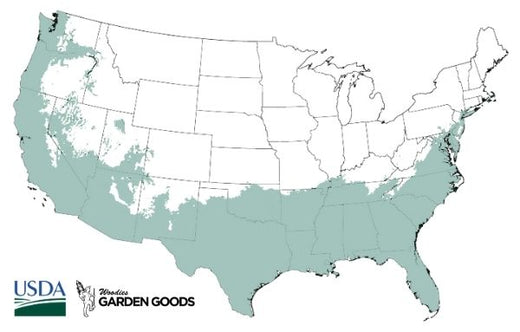
| Hardiness Zone: | 6-9 |
|---|---|
| Mature Height: | 8 - 10 Feet |
| Mature Width: | 8 - 10 Feet |
| Classification: | Mid-sized tree form (10 to 12 feet) |
| Sunlight: | Full Sun |
| Habit: | Deciduous, densely branched, multi-stemmed Small Tree |
| Flower Color: | Bright red flowers in mid to late summer |
| Foliage: | New growth emerges a rich dark purple black changing to dark green in summer |
| Soil Condition: | Any well drained soil |
| Water Requirements: | Water well until established |
| Uses: | Extremely attractive when used as a focal point in the mixed border, mass planting, or a specimen planting |
How to Care for Double Dynamite Crape Myrtle
Be sure to read our planting instructions to ensure a healthy and happy Double Dynamite Crape Myrtle plant for years to come!
How Do I Plant A Double Dynamite Crape Myrtle?
To plant your Double Dynamite Crape Myrtle successfully, choose a sunny location that receives at least six to eight hours of direct sunlight daily to maximize blooming. Crape myrtles thrive in well-drained soil, so be sure to avoid areas where water tends to collect. Start by digging a hole twice as wide and as deep as the root ball. Gently remove the plant from its container, loosen any tightly bound roots, and place it in the hole so that the top of the root ball is level with or slightly above the surrounding soil. Backfill with a mixture of native soil and organic compost, then water thoroughly to settle the soil around the roots. After planting your Double Dynamite Crape Myrtle, apply a 2–3 inch layer of mulch around the base of the plant, keeping the mulch a few inches away from the trunk to prevent rot. Mulch helps retain soil moisture, suppress weeds, and moderate soil temperature. During the first growing season, water deeply once or twice a week to establish strong roots. With proper planting and early care, your Double Dynamite Crape Myrtle will quickly take off, rewarding you with months of dazzling red blooms and vibrant, healthy growth throughout the sunny season.
How Do I Water My Double Dynamite Crape Myrtle?
Watering your Double Dynamite Crape Myrtle properly is essential for establishing a healthy root system and ensuring continuous, vibrant blooms throughout the growing season. During the first year after planting, water deeply once or twice a week, allowing the top few inches of soil to dry slightly between waterings. Deep watering encourages the roots to grow deeper into the soil, making the plant more drought-tolerant over time. Always water at the base of the plant rather than overhead to help prevent fungal diseases and to keep the lush foliage looking its best. Once your Double Dynamite Crape Myrtle is established, it becomes quite drought-tolerant and typically only needs supplemental watering during extended dry periods or extreme heat. Check the soil regularly—if the top 2–3 inches are dry, it’s time to water thoroughly. Applying a 2–3 inch layer of mulch around the base helps conserve moisture, suppress weeds, and maintain a stable soil temperature. Proper watering practices will help your Double Dynamite Crape Myrtle thrive, ensuring months of rich, red blooms and strong, healthy growth in your sunny landscape.
How Do I Fertilize My Double Dynamite Crape Myrtle?
Fertilizing your Double Dynamite Crape Myrtle properly is key to encouraging vigorous growth, rich green foliage, and a continuous display of vibrant red blooms. In early spring, just as new growth appears, apply a balanced slow-release fertilizer, such as a 10-10-10 or 12-4-8 formula, evenly around the drip line of the tree. Be sure to keep the fertilizer a few inches away from the trunk to prevent root burn. Water thoroughly after fertilizing to help the nutrients soak into the soil and reach the plant’s root system, giving your Double Dynamite a strong start to the growing season. For even better performance, consider a second light feeding in mid-summer, especially if your soil is sandy or if you want to encourage extended blooming. Avoid using high-nitrogen fertilizers, as they can produce lush foliage at the expense of flowers. Incorporating organic compost into the soil annually can also naturally enrich your planting area. With the right fertilization routine, your Double Dynamite Crape Myrtle will deliver months of brilliant, reblooming color, making it a bold and reliable centerpiece in your sunny landscape.

How and When Should I Prune my Double Dynamite Crape Myrtle?
Pruning your Double Dynamite Crape Myrtle correctly helps maintain its beautiful form, encourages strong new growth, and maximizes its incredible reblooming potential. The best time to prune is in late winter to early spring, before new growth begins but after the last threat of frost has passed. Begin by removing any dead, damaged, or crossing branches using clean, sharp pruning shears. Focus on lightly thinning the canopy to improve air circulation and sunlight penetration, which supports healthier foliage and more abundant blooms. Always avoid heavy, drastic cutting—often referred to as "crape murder"—which can weaken the plant’s natural structure and diminish its beauty. When pruning your Double Dynamite Crape Myrtle, aim to enhance its natural upright form while maintaining strong, outward-facing branches that allow plenty of room for flower development. Light pruning after the first big flush of summer blooms can also encourage additional flowering later in the season. Regular annual pruning ensures that your Double Dynamite continues to produce vibrant, deep red flowers, healthy foliage, and a strong, attractive shape year after year, making it a true standout in any sunny landscape or garden setting.

